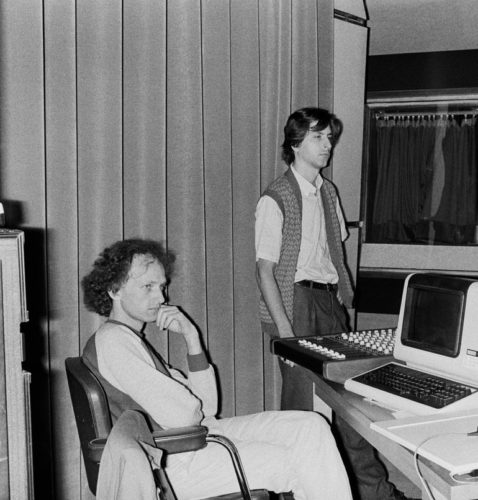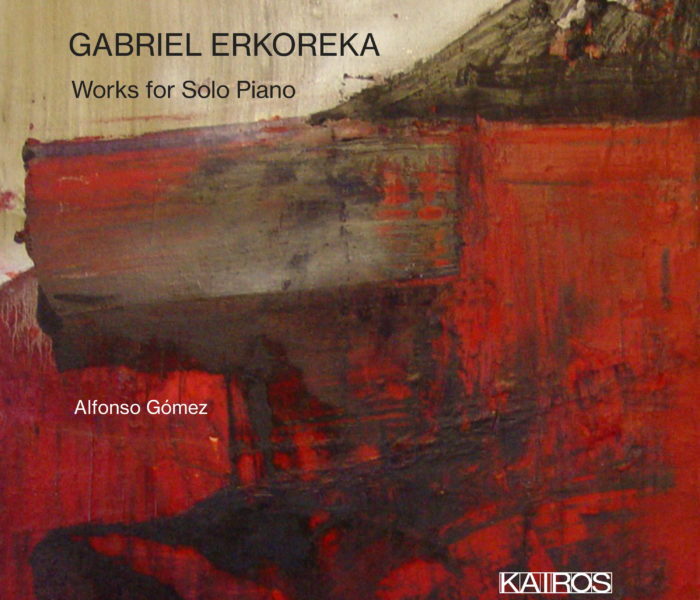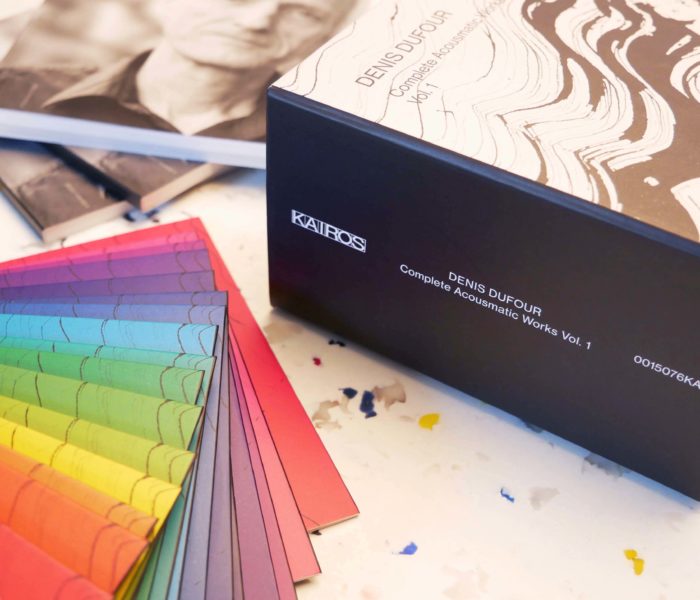For over forty years, Denis Dufour has been a leading figure in creative music. An extremely prolific composer and great experimenter, he claims to "write listening more than sounds". He is best known for his work in the field of electroacoustics, as an heir to Pierre Schaeffer's école concrète, in acousmatic, mixed and live electronic music, concepts which we will define in this article. But Denis Dufour is also a composer of acoustic instrumental music. He approaches this facet of his work with the same curiosity and love of sound matter.
Two recent releases give us the opportunity to meet the composer and produce this dossier: a book of interviews with Vincent Isnard, published in spring 2021 by Musica Falsa, La Composition de l'écoutean invaluable work that retraces the extent of his training and musical career, discusses his compositional methods and the foundations of his teaching, and places his art in perspective with the history of musique concrète and the contributions of Pierre Schaeffer; and the very recent publication of a boxed set of sixteen CDs by Maison ONA and the Kairos label, Complete Acousmatic Works Vol. 1which covers half of his acousmatic work, i.e. forty-four opuses, eighteen hours of music!
That's more than enough to devote a major feature to it in this dossier. We also interview Maxime Barthélemy, from Maison ONA, who enthusiastically explains the energy behind this wonderful project, which may seem a little crazy in these lean times for the recording industry, a project which is still underway, as this impressive body of work is already awaiting a follow-up: the release of the other half of Denis Dufour 's acousmatic works in a second boxed set. To get an idea of the scope of his work, we need to add the same amount of instrumental pieces, i.e. almost two hundred opuses in all.
Let's recall here what "acousmatic music" means. The adjective applies to a sound that we hear without seeing the cause that produces it. This is the experience of listening to the radio. The listener tries to guess the source, opening up the listening experience to the imagination. The concept comes from Pythagoras, who taught his disciples behind a curtain in the 6th century B.C., to prevent them from being distracted by his gestures and facial expressions. Pierre Schaeffer used the term "acousmatique" to define the particular listening experience engendered by his musique concrète, which is based on sounds recorded and then listened to through a loudspeaker. In the "musique concrète" he created in 1948 with his Cinq études de bruit, the composer hears what he is doing as he does it, capturing the sound with a microphone and working directly on this material, just as a painter sees his canvas come to life as he goes along. This is in contrast to the abstract approach of score-based music, where the composer imagines a sound result before being able to hear it interpreted by musicians. During rehearsals, he often has to make minor corrections after the fact, working on the concrete sound.
In musique concrète, recording with a microphone placed close to the sound source means that we often no longer recognize what it originally was, with Schaeffer referring to this source as "anecdotic". Even an "anecdotal sound", whose origin is clearly recognized, can lose this character when placed in relation to other sounds in a concrete composition. In 1966, when he published his Traité des objets musicaux, a new musical grammar, a "solfeggio of the sound object", Pierre Schaeffer hesitated to call it "traité d'acousmatique". After the terms "musique concrète" and "musique électroacoustique", the term "musique acousmatique" was coined. This music has its own compositional rules, as Denis Dufour points out:
"Acousmatic writing takes more time, because it's done with very rich sounds, called "sound objects" or "sequences", which you have to master. Pierre Boulez used to say that you couldn't make music with such sounds, which were far too complex. He called for abstract music made with notes, which are in fact simplifications of sound, produced by instruments that have been worked on for centuries so as to hear nothing but them. All noises, rubs and breaths are erased. It's just a molecule of sound with its separate parameters of pitch, duration and intensity. Acousmatic music, on the other hand, works with sounds in all their richness and complexity.
Born in Lyon in 1953, Denis Dufour began his musical career at the age of fourteen, studying violin and viola. He entered the Lyon Conservatoire in 1972, then the CNSMP (Conservatoire national supérieur de Paris) between 1974 and 1979. Here he studied withIvo Malec (composition), Pierre Schaeffer and Guy Reibel (electroacoustics) and Claude Baillif (musical analysis), among others. Malec, realizing that the young man still had a lot to learn about the composer's craft, advised him to enroll first in an electroacoustic class with Reibel and Schaeffer. The future composer didn't yet know what electroacoustics was, not even knowing the word, but he immediately felt at home in the world that was to become his own. In 1976, he began collaborating withIna-GRM, the Groupe de Recherches Musicales founded in 1958 by Pierre Schaeffer, who had just joined the Institut National de l'Audiovisuel in 1975. This collaboration continued until 2000. His first compositions date from the late seventies.
In 1977, GRM director François Bayle asked Denis Dufour to co-found the GRM trio with Laurent Cuniot and Yann Geslin, which would become the TM+ ensemble, a live electronic music group:
"There was this idea of experimenting with what could be done live with synthesizers, which weren't very sophisticated at the time. [...] We started with instruments that were still monodic, without keyboards, accessed with buttons and joysticks. We invented a way of playing and fixing in order to be able to reproduce: in fact, we didn't improvise on stage, even if we did practice it to work and experiment at the source of the pieces. From there, we thought about more structured compositions."
Denis Dufour is a composer and teacher (at the Lyon and Perpignan regional conservatories, the CNSM in Paris, the CRR in Paris and the Pôle Supérieur d'Enseignement Artistique de Paris Boulogne-Billancourt). After TM+, he founded the ensembles Les Temps modernes (1992) and Syntax (2004). In 1992, he helped create the Festival Futura in Crest, devoted to acousmatic music and the media arts, which he directed until 2006. In 1996, he set up Motus, a publishing, production, training, concert and event organization structure.
This fine career becomes even more impressive when we learn from Vincent Isnard's book of interviews that the young Denis Dufour was not at all fond of the contemporary music he heard while regularly attending concerts in Lyon. Discovering Krzysztof Penderecki 's famous Thrène à la mémoire des victimes d'Hiroshima (1960) at the age of sixteen or seventeen, he found the work "very smoky at the time, unintelligible", going so far as to assert that "it was really noise, for [him]" (p. 13). A little later, however, he is surprised to recognize the piece on the radio, and discovers that it has an identifiable form, and therefore an interest. He confides: "That's how I understood that this music wasn't just any old thing, that it was worth listening to, and that I was going to continue my process of going towards this music I didn't know yet."
One of Denis Dufour's major contributions to the world of music in the '80s was the development of the acousmonium concept, a loudspeaker orchestra established in 1973-1974 at GMEB (Groupe de musiques expérimentales de Bourges) and GRM. The idea was born as early as 1952, when Pierre Schaeffer and Jacques Poullin drew up the first foundations for thinking about sound projection and its use in space. The term "acousmonium", derived from "acousmatic music", was coined by François Bayle in 1974. Initially, the device was conceived in a frontal, unspatialized way, with just two low-quality rear and side speakers, imitating the orchestra, with high and low speakers imagined as instrumental sounds.
"I came into this world at the birth of the acousmonium. [...] I had the idea of making it a transportable device in the early 1980s. At the time, it was very heavy and expensive to move around. [...] I set up my version privately, for my class in Lyon. I upgraded it by putting speakers everywhere, making it totally immersive. [...] An acousmonium can have up to forty, fifty or even a hundred speakers. I made the settings evolve, so that the potentiometers on the projection console were coherent with the device, and I insisted on the importance of tuning it to the venue, to eliminate parasitic resonances and buzzing, and to avoid gaps between speakers when moving a sound around. I went on to teach all these techniques. One of my students, Jonathan Prager, has gone on to become one of the leading performers of acousmatic music."
The interpreter must therefore be perfectly familiar with the works he or she is playing, so as to be able to spatialize them, reinforce contrasts and dynamics, play on colors, sound speed and density, and adapt to the venue as well as the audience. Denis Dufour willingly entrusts his acousmatic works to performers, because he believes that a composer is not the best person to play this role. He'll want everything to be heard, rather than emphasizing contrasts.
Contrary to the image one might have of the solitary studio work of an electroacoustic composer, Denis Dufour often works as part of a team, multiplying his collaborations. His acousmatic music, for example, is frequently based on texts. He has worked regularly with Thomas Brando since 1986 (their first collaboration dates back to 1981). This author, art director and graphic designer has written and produced numerous projects that Denis Dufour has then set to music based on his texts and intentions. Hamish Hossain, one of the composer's students, is also present, as narrator on Les Cris de Tatibagan and as diphonic and throat singer on the Missa pro pueris. This creative environment is combined with a vast amount of preparatory work: patient research into documentation and a long period of maturation designed to nourish his projects in depth. Denis Dufour takes on the image of the director, benefiting from the talent of the many specialists around him, whom he coordinates to bring his film to fruition.
The acoustic music written by Denis Dufour is arranged in the same way as his acousmatic music, based on the thought of sound morphology and the writing of listening:
"You have to compose perception, not notes, not even sounds. Perception is what goes on in the head. We see, hear, feel and touch things through what goes into our ears. When I compose, I have to think about what people are going to feel tactilely, sonically, visually and emotionally."
A fine example of this can be found in the transcription of theÉtude aux sons animés by Pierre Schaeffer (1958), which Denis Dufour rewrites for flute, alto saxophone, bass clarinet, trumpet and cello in Stele for Pierre Schaeffer (2013).
Denis Dufour, now retired from his teaching activities, has settled with his brother Hervé at the Abbaye de Lanvaux in Brittany's Morbihan region. They are currently working on the site, which comprises the ruins of a 12th-century Cistercian abbey and a 17th-century abbey house, with a view to transforming it into a creative space with its own studio and archives, a concert hall and a venue for artistic workshops and residencies in music, singing, literature and yoga.
Guillaume Kosmicki
You can listen to Denis Dufour with Guillaume Kosmicki on Radio Breizh in a series of three programs(Program 1, Program 2, Program 3).



)






